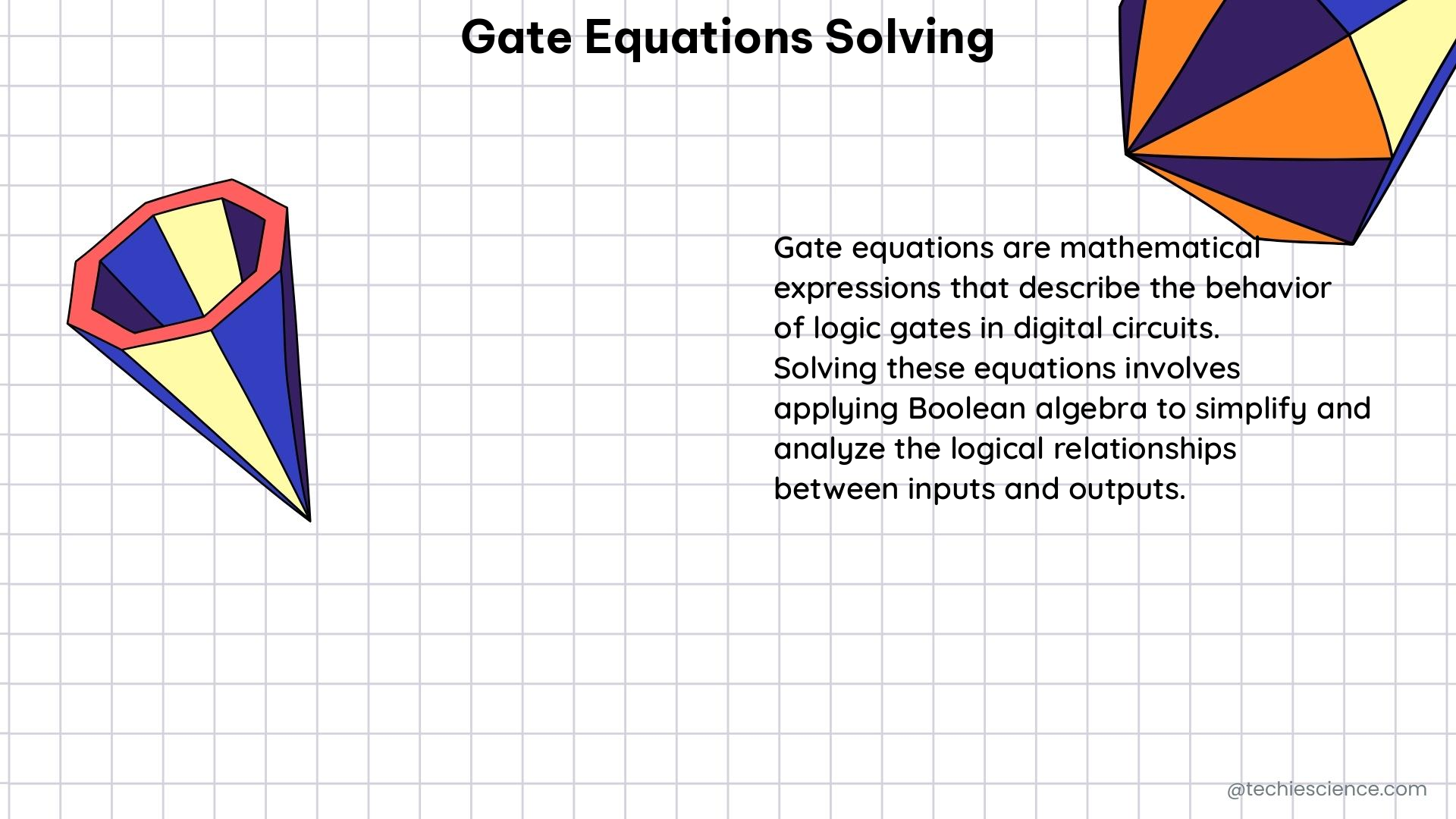Gate equations are a fundamental concept in electronic circuit analysis, as they describe the relationships between voltages, currents, and other electrical quantities in a circuit. Solving these equations is a critical skill for electronics students, as it allows them to analyze and design complex electronic circuits with confidence. In this comprehensive guide, we will explore the various techniques and methods used to solve gate equations, providing a detailed and technical manual for electronics students.
Understanding the Gate Equation
The gate equation is a mathematical representation of the behavior of an electronic circuit. It is a set of equations that describe the relationships between the voltages and currents in the circuit. The gate equation is typically a system of nonlinear differential equations, which can be challenging to solve analytically.
The general form of the gate equation can be written as:
F(x, y, z, ...) = 0
where x, y, z, etc. are the electrical quantities (such as voltages, currents, and charges) that describe the behavior of the circuit.
Numerical Methods for Solving Gate Equations

Due to the complexity of the gate equation, numerical methods are often used to find approximate solutions. The most common numerical methods used to solve gate equations are:
Finite Difference Method
The finite difference method is based on approximating the derivatives in the gate equation using finite differences. This method is simple to implement and can be used to solve problems with complex geometries. However, it can be computationally expensive and may not provide accurate solutions for problems with rapidly changing solutions.
Finite Element Method
The finite element method is based on dividing the domain of the gate equation into small elements and approximating the solution within each element. This method is more accurate than the finite difference method and can handle complex geometries and boundary conditions. However, it can be computationally expensive and may require specialized software.
Boundary Element Method
The boundary element method is based on representing the solution of the gate equation as a sum of boundary elements. This method is particularly useful for problems with complex geometries and boundary conditions. However, it can be computationally expensive and may require specialized software.
Theorems and Formulas for Solving Gate Equations
To solve gate equations, it is important to have a deep understanding of the electrical engineering principles that govern the behavior of electronic circuits. Here are some key theorems and formulas that are useful for solving gate equations:
Theorem 1: Uniqueness of Solution
The gate equation has a unique solution if the circuit is well-posed, i.e., the number of independent equations is equal to the number of unknowns.
Formula 1: Ohm’s Law
The voltage drop across a resistor is given by Ohm’s law: V = IR, where V is the voltage drop, I is the current flowing through the resistor, and R is the resistance.
Example 1: RC Circuit
Consider a simple RC circuit consisting of a resistor and a capacitor in series. The gate equation for this circuit is given by:
dV/dt + (1/RC)V = (1/C)Iin
where V is the voltage across the capacitor, Iin is the input current, R is the resistance, and C is the capacitance.
Numerical Problem 1: Solving the RC Circuit
Solve the gate equation for the RC circuit in Example 1 using the finite difference method with a time step of 0.1 ms and a total simulation time of 10 ms.
Theorem 2: State-Space Representation
The gate equation can be written in state-space form as:
dx/dt = Ax(t) + Bu(t)
y(t) = Cx(t) + Du(t)
where x(t) is the state vector, u(t) is the input vector, y(t) is the output vector, A is the system matrix, B is the input matrix, C is the output matrix, and D is the feedforward matrix.
Formula 2: Transfer Function
The transfer function of a linear time-invariant system is given by:
H(s) = C(sI - A)^(-1)B + D
where s is the complex frequency, I is the identity matrix, and H(s) is the transfer function.
Example 2: RL Circuit
Consider a simple RL circuit consisting of a resistor and an inductor in series. The gate equation for this circuit is given by:
L di/dt + Ri = V
where L is the inductance, R is the resistance, i is the current flowing through the inductor, and V is the input voltage.
Numerical Problem 2: Solving the RL Circuit
Solve the gate equation for the RL circuit in Example 2 using the finite element method with a mesh size of 0.1 mm and a total simulation time of 10 ms.
Conclusion
Solving gate equations is a critical skill for electronics students, as it allows them to analyze and design complex electronic circuits with confidence. By mastering the techniques and methods presented in this guide, electronics students can develop a deep understanding of electrical engineering principles and apply them to solve real-world problems.
References
- Quantitative Analysis- Definition, Methods, Techniques … – BYJU’S
- ALEKS: Setting up the math for a two-step quantitative problem
- Parabolic Equations with Measurable Coefficients | Request PDF
- How to solve equations fast ? : Quantitative Questions – GMAT Club
- A Certain Property of Solutions of Parabolic Equations with …

The lambdageeks.com Core SME Team is a group of experienced subject matter experts from diverse scientific and technical fields including Physics, Chemistry, Technology,Electronics & Electrical Engineering, Automotive, Mechanical Engineering. Our team collaborates to create high-quality, well-researched articles on a wide range of science and technology topics for the lambdageeks.com website.
All Our Senior SME are having more than 7 Years of experience in the respective fields . They are either Working Industry Professionals or assocaited With different Universities. Refer Our Authors Page to get to know About our Core SMEs.